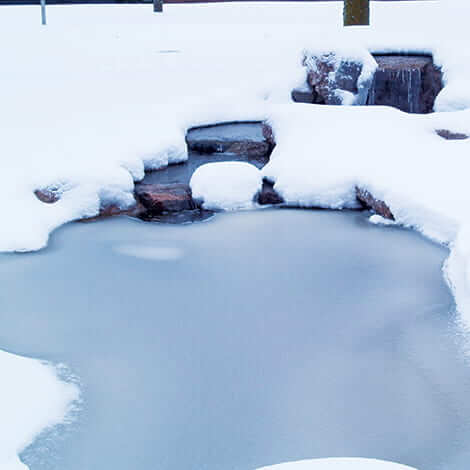Relaxing by your waterfall with a warm cup of cocoa in winter may sound tempting, but it can cause more stress for you and your fish in the long run. Depending on your climate, running pond pumps in winter can be detrimental and costly. Before you decide to run or shut down your water garden features for winter, here are a few points to consider:
Identify Winter-Safe Pond Pumps
Ponds and water gardens have many components that utilize pumps. While pond air pumps—commonly known as compressors—on aeration systems are safe to use year-round, other pumps might get damaged in wintertime. Generally, any pump that moves water should be removed before the first freeze. This includes waterfall pumps, water feature pumps, and fountain pumps.
To be safe, double-check your manual’s recommendations for winter use or storage, as some pumps are not designed to be used during freezing conditions. Doing so could void your warranty and damage equipment, leading to expensive pond pump repairs or replacements.
Ice Damages
In northern climates with freezing conditions, ice dams can develop and divert water from the pond. Ice also expands, taking up more space and making it difficult to see water level changes. Pumps need a constant supply of water, so if your water level drops too much, it could damage or destroy pond pumps.
Pond Pump Costs Compared
Waterfall pumps can be expensive to operate full-time, especially during winter. A deicer keeping the hole open in your ice is not much better since these units can also get costly.
In contrast, aeration systems can cost less than $2 per month to operate 24/7. An aerator efficiently circulates the water, keeping a hole open in the ice with or without the help of a small deicer. Additionally, properly aerating a pond throughout the year will help keep your ecosystem more balanced.
Even in their semi-dormant state, fish need oxygen. During winter, some pond owners only use their water pumps a few hours per day to cut the cost of running a pump. Depending on your local climate, part-time winter pump use might not keep a hole open in the ice or infuse enough oxygen into the pond.
In water gardens deeper than two feet, waterfall pumps alone will not provide aeration to the deepest depths. Lack of fresh oxygen can cause your fish to become stressed and more susceptible to disease.
Store Pond Pumps in Winter
We recommend storing your pond pumps in winter to prevent the risk of damage to your pump and water garden. To winterize your pump, submerge it in a five-gallon bucket filled with water to keep the seals lubricated. Store the bucket where it will not freeze, like a basement or heated garage.
Pond Pump Winter Use Questions
Do you have more questions about how to winterize your water garden equipment? Don’t hesitate to contact our friendly pond pros at 866-766-3435! Plus, check out more winter pond guides below:
Winterizing Pondless Features
How to Winterize a Pond
Winter Pond Aeration Guide
Removing Your Fountain for Storage
Last Updated: June 26, 2024
